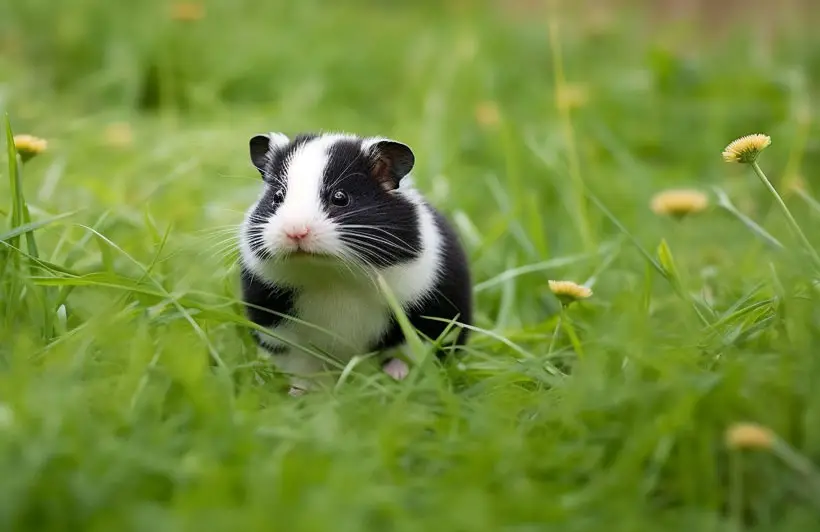Panda Bear Hamster Care: Food, Habitat, Health, Tips and Facts
New panda bear hamster owners sometimes think that keeping them is a challenge. Luckily, the good news is that caring for them is similar to caring for any other hamster breed.
So, how do a panda bear hamster care? It’s simple. You should provide your hamster with a balanced diet, a big clean cage, keep it groomed and give it enough toys to keep it active. Moreover, clean bedding will help your hamster stay healthy and keep the cage clean.
In this guide, we’ll briefly talk about all these necessary points to help you get a proper idea about their care needs.
Panda Bear Hamster Care: What You Need to Do
There are a few panda hamster names, such as bear hamster, Syrian hamster or panda bear hamster. This hamster breed looks like a mixture of pandas and bears, thus the various names for it. While they’re not exactly the Syrian hamster people know, they are a specific variation of the Syrian one.

Panda bear hamsters have been considered one of the easiest hamsters breeds that are easy to care for. A good living space, proper food, and health maintenance are mostly all that they need to have a peaceful life.
Let’s talk about how to take care of them and ensure they’re getting their needs met in the best possible ways. We’ll also learn a few facts about these small, interesting creatures then.
Diet
Panda hamsters don’t have a specific diet that is different from other hamster breeds, so you can follow the basic diet guideline for all hamsters.

- Most hamster owners like to feed their pet hamsters only a pellet diet. While good brands’ pellets have a balanced nutrition profile, they shouldn’t be the only thing the pets get.
- Another two things to avoid feeding them are sugar and fat. Any food with high sugar or fat content, such as sweets, chocolates, and red meat, should always be avoided.
- Panda bear hamsters are highly prone to diabetes. Feeding them a high-fat diet may cause their arteries to be blocked from plaque build up or cause weight gain from the extra calories.
- A balanced diet should include fruits and vegetables for fiber and other nutritional needs. People commonly feed panda hamsters carrots, broccoli, apples and other fresh fruits and veggies.
Activity and Feeding
A wild hamster’s major activities consist of digging tunnel-shaped burrows underground as well as finding and storing food in the burrows.
However, in captivity, a hamster can be given a running wheel, a hamster ball, or maybe some pet ropes or mazes. Running wheels are the most common hamster toy because hamsters love to run in them.
Moreover, a running wheel can keep a hamster physically fit and help its bones to strengthen.

In the wild, hamsters eat grasses, insects and grains, and they basically load their bellies with these. Without food, they won’t have enough energy to sustain their many activities. So it’s best if you can feed your panda hamster after it wakes up, which is the evening time.
- A panda hamster’s mouth has a soft pouch around it. If it chews a sharp piece of food, it may rupture the pouch, so try to give it grains and seeds after breaking them first.
- As panda hamsters are omnivores, occasionally feeding them protein is a good idea.
- Increase or decrease the amount of protein depending on their activity levels.
- And finally, to keep their teeth in the best shape, sometimes give them hard but chewable foods. This’ll allow them to help their teeth in shape by chewing hard.
- Make sure not to give them sticky foods since these can get stuck inside their mouth pouch or between the teeth.
Cage Size
The larger a hamster’s cage is, the better it is for the animal. It should be at least 100 cm long x 50 cm wide X 50 cm high. A cage of this dimension has 5,0002 cm of floor area. This is a minimum surface area recommended by experts.

If it’s possible to get a larger cage, go for it. As the pet spends most of its time inside the cage playing, exercising, and doing other activities, a larger surface area will allow it to move freely while it’s in the cage. You don’t necessarily need a taller cage because hamsters don’t spend much time climbing; they’re almost always on the cage floors.
Grooming
A panda hamster doesn’t need much grooming except for nail and fur cleaning. When nails get long, more bacteria get to reside inside them.
- Cut the nails of your panda hamster when they get long and once they’re smaller, clean the underneath of the nails using a brush. Use a pet nail trimmer for trimming the nails.
- For fur cleaning, take a pet fur cleaning brush and thoroughly clean the fur coat of the hamster.
- Respiratory and skin infections can be caused by dust or dirt from the cage residing on the hamster’s skin. Regular fur cleaning will ensure the hamster is mostly free from these risks.
Other than maintaining these, caring for a panda hamster isn’t a difficult task.
Health Checkup
Hamsters are quite clean and don’t get affected by diseases easily. Still, illnesses happen, so if you notice any unusual signs, such as a lack of activity or movement in your hamster, try to get it checked by a vet. A regular vet visit is basically half the hamster care that is necessary.

Let’s talk about a few signs of a sick hamster. If you notice any of these, it’s highly likely that your hamster might be sick.
- If your hamster hunches all the time, it could be a sign of possible muscular weakness. You should make sure it has exercise toys and a spacious cage. Also, feed it wheat germ and wheat germ oil to prevent any risks of paralysis from muscular weakness.
- Sticky food, if it gets stuck in a hamster’s pouch, may cause it to have runny eyes. Clean the pouch with water in cases like this.
- Lice and fleas can live on a hamster’s skin and drink blood from it. Use flea powder or take your hamster to the vet to get your hamster cleaned.
- Lumps on the skin might be a sign of a tumor. Give your vet a visit immediately.
- If you notice that your hamster’s tail is always wet, it’s possible that it has diarrhea. Stop feeding it fiber-rich food such as fruits or veggies for a day or two. Also, constipation may happen if there’s a lack of fiber from a hamster diet. So a balance is necessary.
Besides these issues, a hamster may get other bacterial or viral infections. A vet will be able to identify and give proper treatment by checking the animal carefully.
Cage Cleaning
A clean cage is a must for ensuring the optimal living experience for a hamster. Let’s talk about a few ways to keep your hamster’s cage clean:
- Replace a part of the bedding once or twice every month, depending on the thickness level of the bedding. If the bedding’s thick and has more volume, you may replace it less often. It’s best not to replace all of it at a time because the old bedding’s smell makes hamsters feel better.
- Using a spoon, take out the poop spots from the bedding. Hamsters pee poo in specific places in the cage, so this wouldn’t be much hard work.
- Remove the pee-soaked bedding once in a while using a pet bedding scooper. Letting pee-soaked bedding stay in the cage for a few days will create a bad smell inside the cage.
- Sometimes cleaning the cage and its bars, toys, and bowls is necessary to prevent possible bacterial invasion. Cleaning these doesn’t have to be done weekly. Once a month is enough.
- Make sure to use an unscented pet disinfectant to clean these items. Anything scented will change the natural smell of the cage and bedding, causing a stressful time for the panda hamster.

Cage Mates
Panda bears don’t like the idea of sharing their cages.
- Don’t keep any other hamster breeds in the same cage you’re housing your panda bear hamster in.
- In fact, there should be no pet cages adjacent to the panda’s cage.
- Panda hamsters are aggressive and may get into a fight with another pet if they get a chance. This may get both or one of them hurt in the process.
Facts about Panda Hamsters
We’ve talked about the food, health and care needs of panda bear hamsters. Let’s have a look at a few interesting facts about this tiny creature.

- Panda hamsters have become very popular lately in the pet market, but they were actually discovered in the late 18th century. They were found in the middle east, near Syria as they’re basically a variation of the Syrian hamster.
- They look like bears because of the black patches of fur, similar to pandas and bears. For this exact reason, they’re commonly known as panda bear hamsters.
- Unlike humans, hamsters don’t sleep in a single session. They break their sleep time into chunks and cover their shut-eye needs in multiple sessions.
- In total, they can sleep 12-14 hours. However, panda bear hamsters sleep in the daytime and stay up mostly after the evening throughout the night.
- Some people wonder, are panda bear hamsters friendly? The answer is, sadly, negative. These hamsters are the least social hamsters you can get. If you can train them well, they’ll make good pets, but it’s a long process to tame them.
Frequently Asked Questions
Now let’s move on to talking about a few commonly asked questions on panda bear hamster care.
Q: Can you bathe a panda bear hamster?
You can bathe your panda hamster, but just make sure not to get shampoo or soap inside its eyes. You can find hamster-safe or guinea pig-safe soaps and shampoos at your local pet stores.
Q: How long do bear hamsters last?
Usually, 2-3 years if the living conditions are right for them. There has been a record of a hamster living for 7 years in captivity, but that’s an exception, at least until now.
Q: Can bear hamsters eat cheese?
No. It’s best if you don’t feed them cheese. Cheese contains high-fat content, which is bad for your panda hamster’s health. But if you decide to feed it some cheese, take a pea-sized bit and feed it once every two weeks. They should be fed cheese no more than once a week by any means.
Final Words
Hopefully, you now have no confusion regarding their care needs and have gotten some ideas on keeping them in the best shape. Make sure not to irritate them as they can get quite aggressive. Also, it’s best to keep them away from children for this exact reason.
The panda hamster breed is popular for its cute looks and fur patches, and keeping them in the best care can help you create a beautiful attachment with it. So, fulfilling their basic needs is all that they need to live a happy and peaceful life.




